Earthquake-Resilient Tower Design Competition 2022
IEM EARTHQUAKE-RESILIENT TOWER (ERT) DESIGN COMPETITION 2022
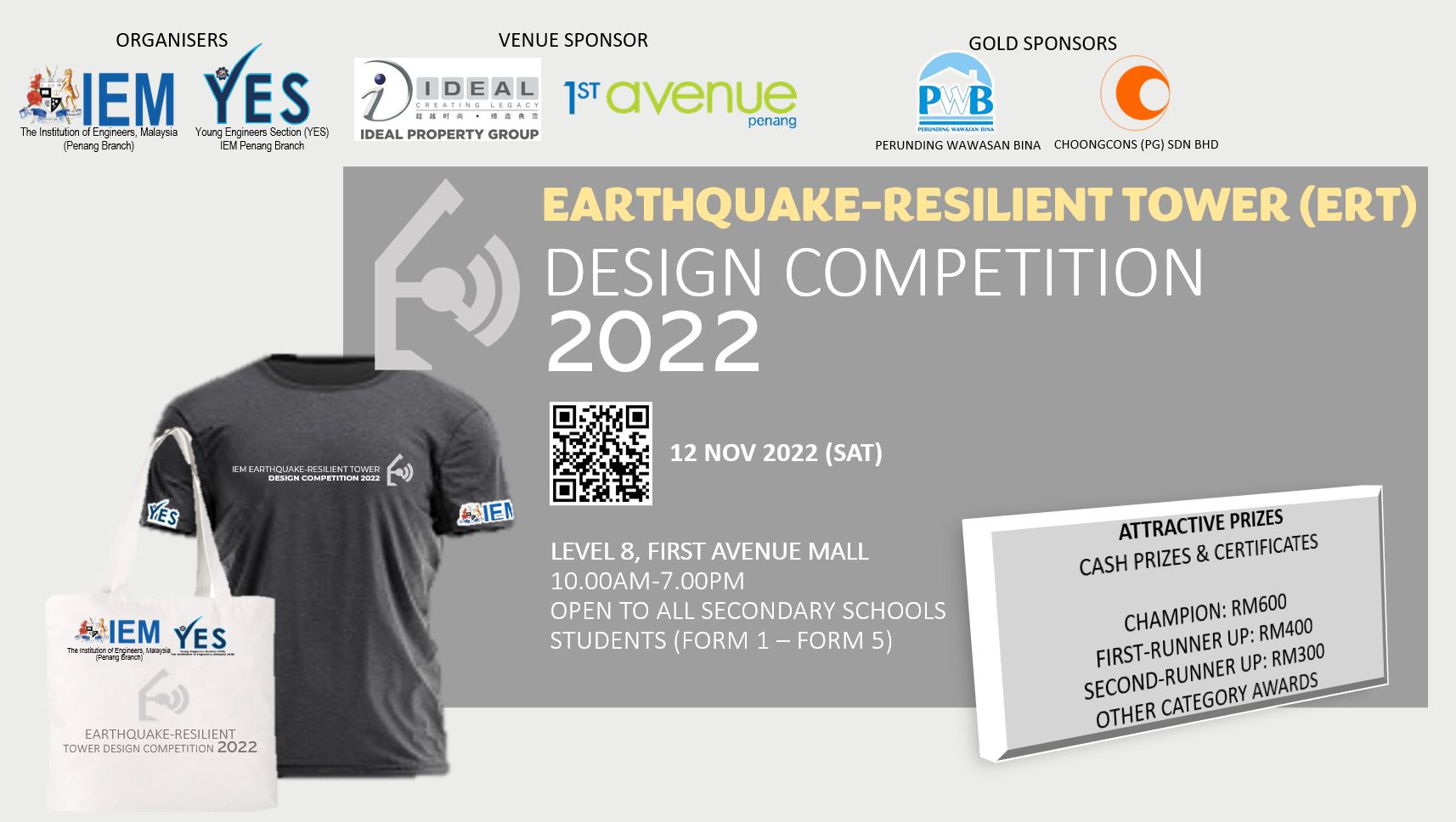
Overview of Competition:
The IEM STEM Earthquake-Resilient Tower (ERT) Design Competition is a one-day STEM competition open for all secondary school students.
The main objectives are to encourage STEM participation among students while promoting awareness about earthquake-resilient designs among students.
- Each team shall consist of 3-4 team members from the same school, under the supervision of a teacher-in-charge.
- A maximum of 3 teams (registration based on first-come-first-served basis) are allowed to represent each school. (Updates: By now, the entries to this competition may already be full. If you were notified that the registration is full after your registration, your registration will be put into our wait list. Your team will only be entitled to the competition should there be withdrawals from the earlier-registered teams. In such event, you will be notified through email. Otherwise, if you do not receive any follow up emails, it is deemed that the registration is still full)
- Nonetheless, you are still welcomed to join in the competition as spectators.
- The 4th and subsequent teams from the same school shall be subject to the approval of the organising committee.
- The Competition Overview:
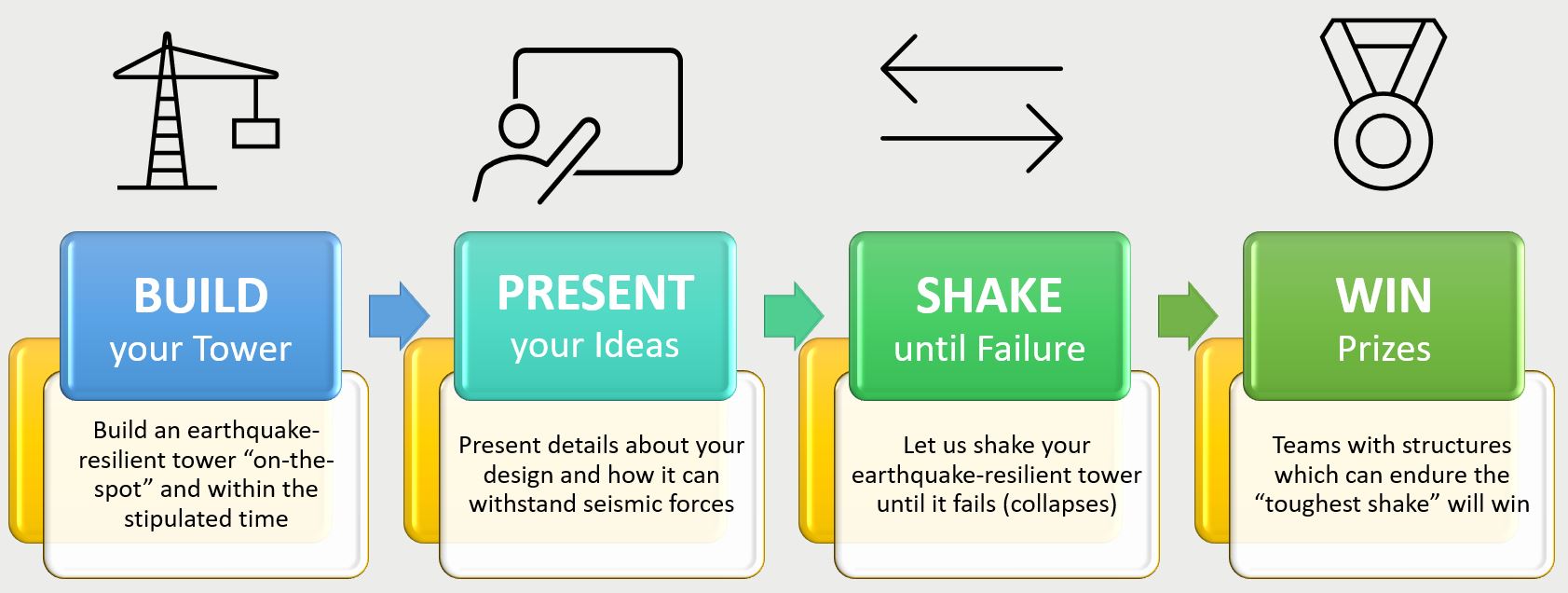
Tools & Materials
- All the materials for the tower design will – and shall only – be provided by the organiser during the event day.
- Please be reminded that the model construction will be done "on-site" or "on-the-spot" during the competition day, during which the organisers will provide all tools and materials required for the model building. During the event day, all teams will be provided with an allocated time for the construction and only the tools and materials provided by the organiser shall be allowed for the model construction. Therefore, all teams will NOT be required to pre-build any models before the competition date.
- The organising committee reserves full right to make changes to any part of the competition from time-to-time.
- All Participants should not use their own materials, including glue/any other devices to form any part of element or connection/adhesives of the structural model.
- Tools: Cutter, pencil and measuring tape. Own tools for marking, cutting, measurements etc. may be allowed.The main materials used will be Balsa wood and the details shall be disclosed to the participants when the competition is near.
- All participants shall exercise safety precautions as their first priority in the project construction including the use of sharp tools and adhesive materials.
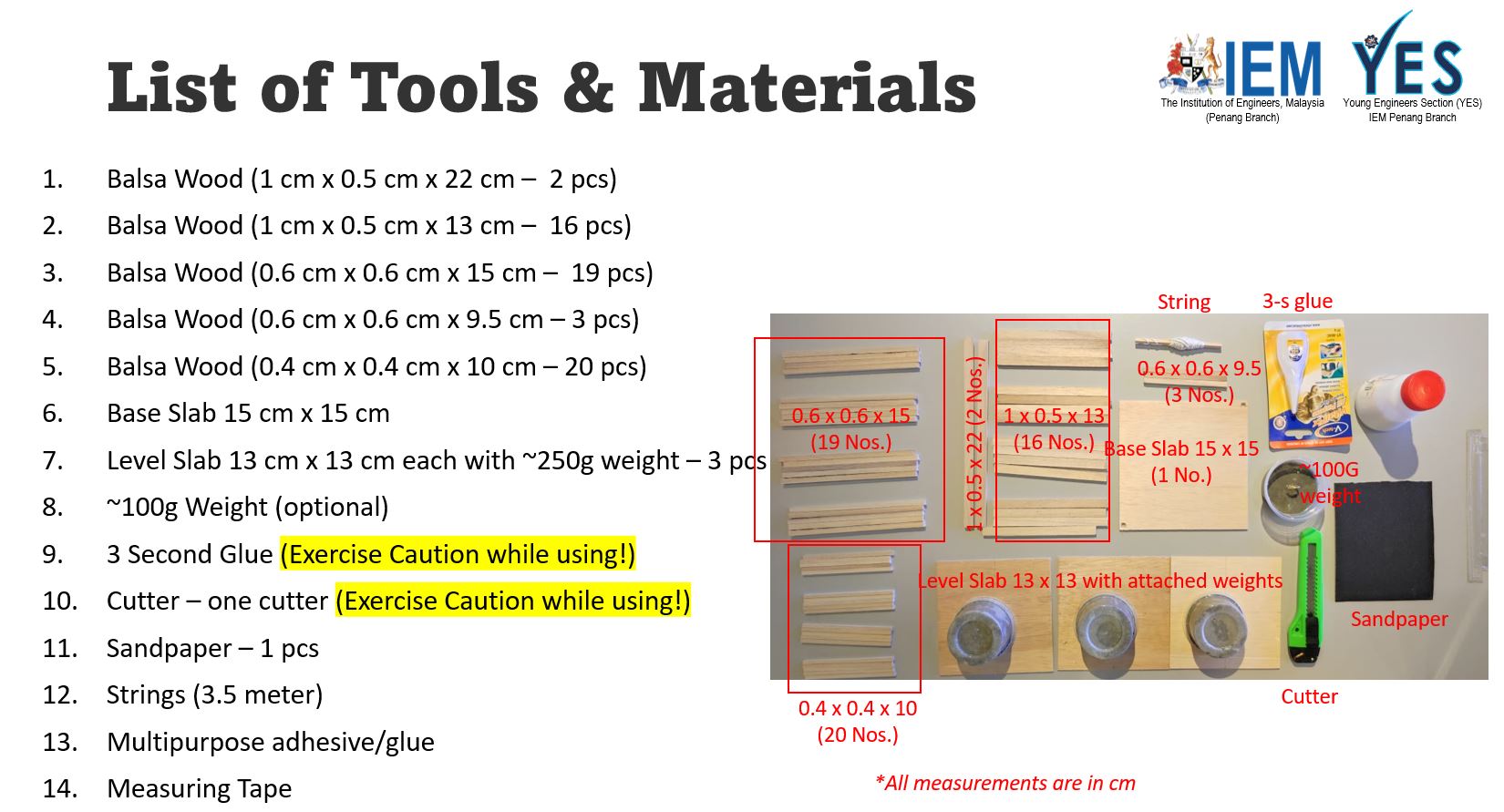
Tower Construction
- Each team will need to construct a 450-mm (minimum height) tall earthquake resilient tower only with the limited materials provided.
- Each team get three (3) numbers of 250-g weights mounted on 3 wooden slabs provided by the organiser. The highest one has to be mounted at 450mm (minimum height) on the earthquake-resilient tower, measured from the base of the tower to the base of the weight.
- All THREE (3) weights are compulsory loadings for your tower, and you SHOULD NOT remove the weights from the slab.
- The basic features of the model are illustrated as below:
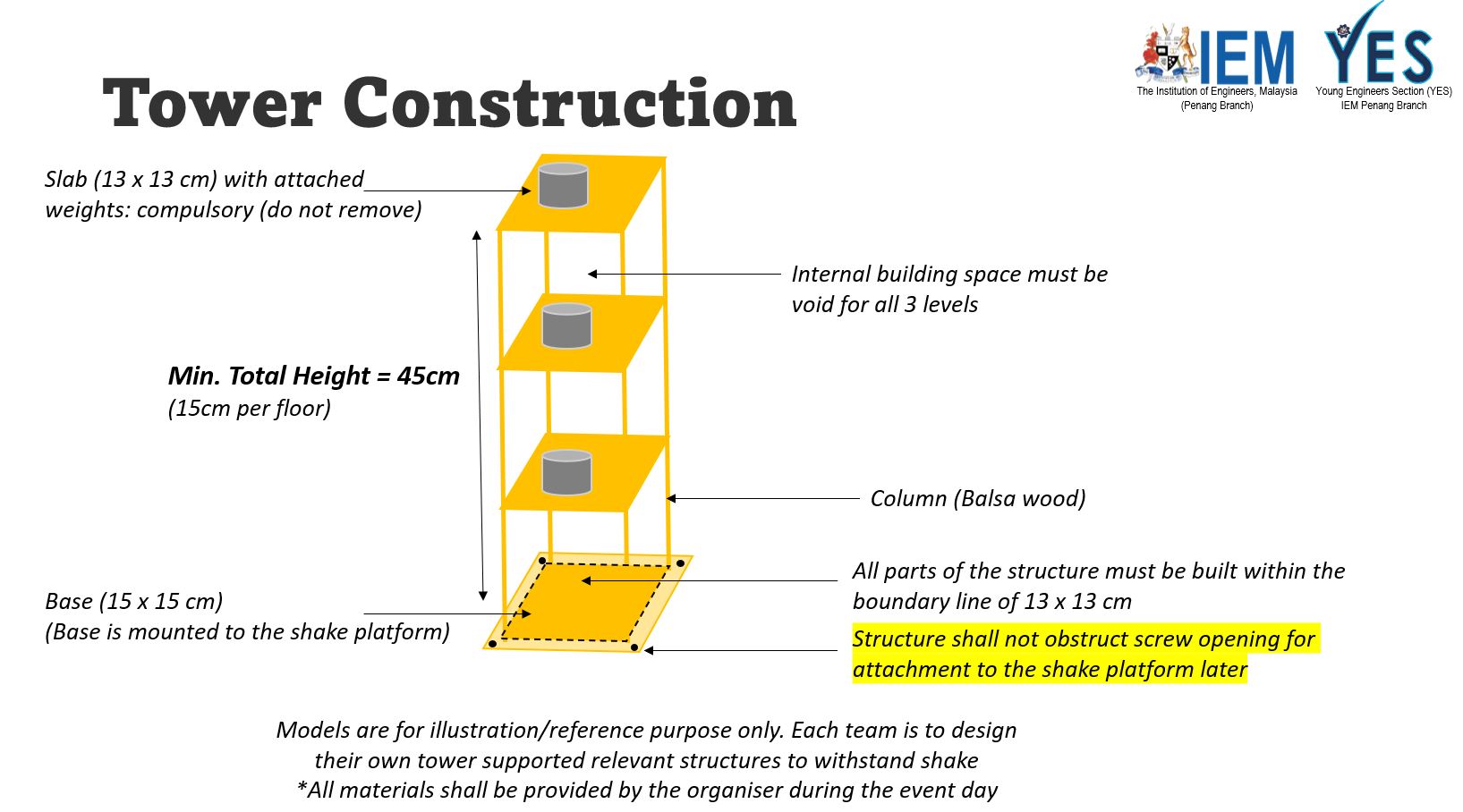
- The entire structure shall be built on top of 150mm x 150mm base, with an offset of 1cm from each side for screw (model base: 130mm x 130mm). No parts of the structure shall be allowed to exceed the area, and no obstruction for the screw holes shall be allowed.
- It is not necessary to add claddings or decorations to the models for the purpose of aesthetic appearance.
- Additional loading of ~100-g block will be provided. It is optional whether you would like to mount this weight onto your tower.
Testing & Shaking
- The earthquake-resilient tower will be affixed onto a shaking table to test its ability to withstand various earthquake levels.
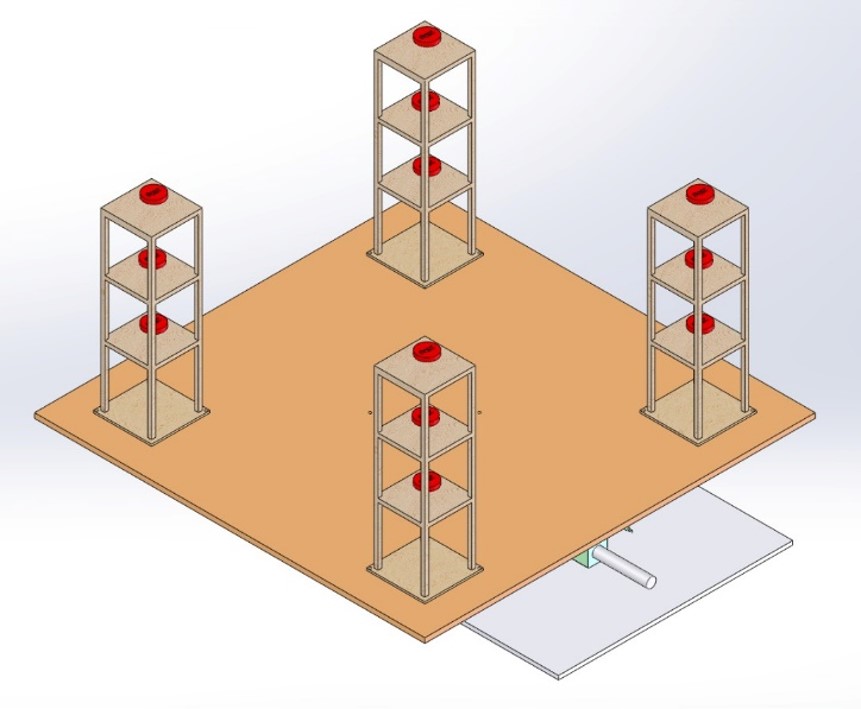
- The Earthquake Shake Table is an earthquake-simulating device that shakes laterally in a single axis. It is designed to test the stability of a structural models with adjustable shake frequencies.
- Each team will need to place the tower on a shake platform to be tested based on Table 1.
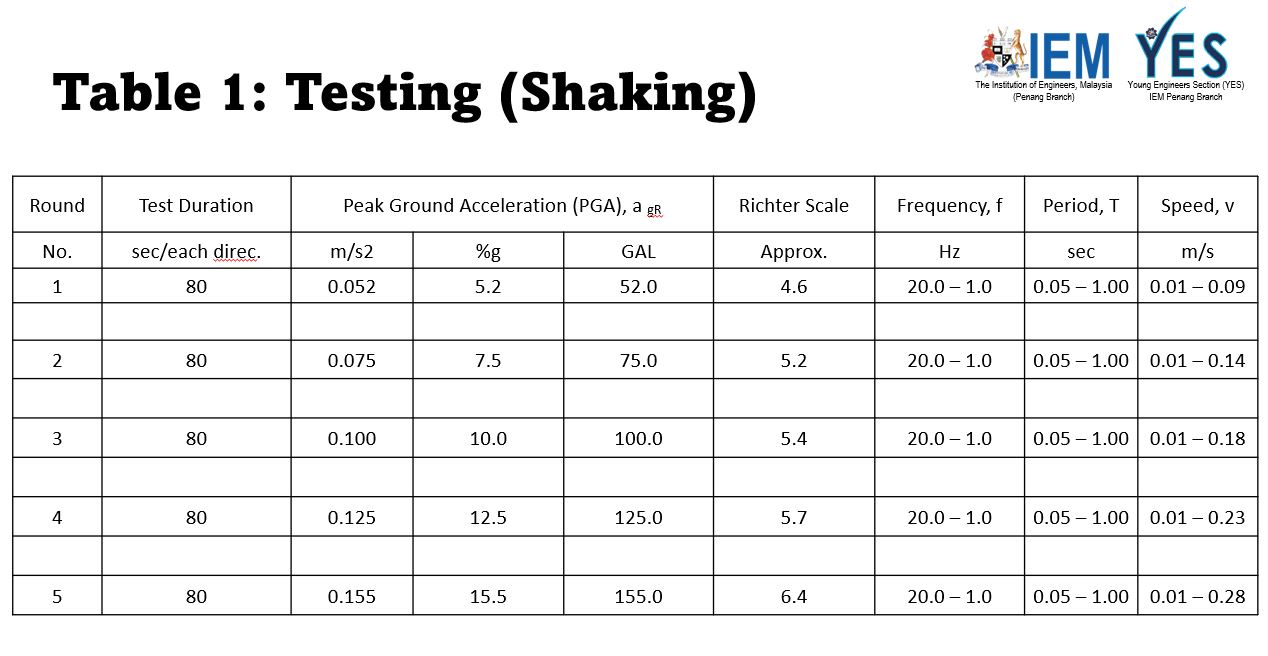
- Should there be any model that passes the strongest frequency of shake, the models may be contested again among other “strongest” models. No modification/repair to the structures will be allowed once the competition begins.
- The point of failure shall be announced when
a. the tower collapses; or
b. the tower is no longer holding the weight properly at designated heights; or
c. the tower slanted extensively; or
d. Important structural elements gives way; or
e. it is announced so by the panel judges. The judges’ decision is ultimate and non-challengeable.
Grading Rules
- The total scores are computed for a team based on stability of the team’s model, where
Stability = The highest shake that a model can withstand (from Round 1 to Round 5). Round 1 is the “mildest” shake and Round 5 is the “strongest” shake. - Students shall mount their model to the shake platform themselves using the given bolts and nuts, after they presented their model to the judges. In between each round of shake, students are not allowed to touch their models.
- Should there be more than 1 model that can withstand all 5 rounds of shaking. The models may be contested in another round of competition with longer or “stronger” shake. If there is still no clear winner after prolonged period of time, the judges will make decision for the winner based on the averaged scores awarded to the team. The judges have the final say to award to the winner.
- Other category prizes may also be announced (subject to changes and discretion by the organising committee):
- Creativity – Use of new design concepts that are innovative and applicable
- Presentation – Clear, Concise and Relevant Presentation. Each group must present to the judges for NOT more than 5 minutes/team to explain about their model before it is being tested. There will be Q&A from the judges for 3 minutes following the presentation.
- Resource Management – Use the least materials for maximised outcome: stability.
- No extra time will be given if any group is unable to complete the model within the given time.
- Participants will NOT be allowed to make any sort of changes to the model afterwards, unless instructed by the organising committee due to non-compliance of the weight-mounting.
- In such events, the team member will only be allowed to make changes in terms of the weight mounting but not any others.
- Teams will be disqualified if materials other than those provided are found in the model, or if the team fail to mount the weights per specified in the requirements.
- Other violation of rules and penalties:
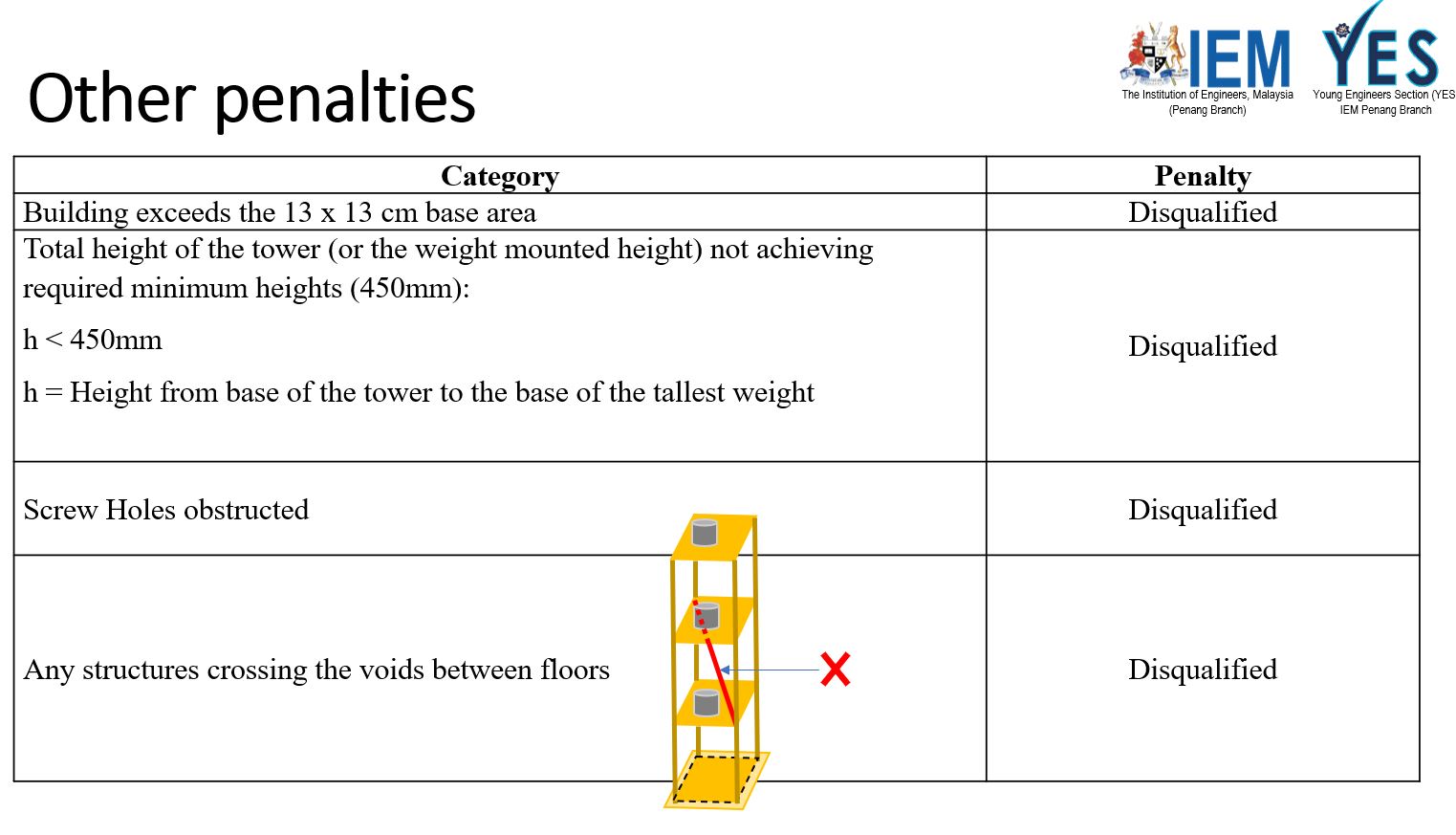
*DISCLAIMER: The organising committee reserves the right to make changes to the Rules and Regulations without notice. The final set of rules and regulations will be made available to tha participants during or before the event day. Judges decision are final and no challenges will be allowed.
ASSESSMENT SCORES (MARKING RUBRIC) BY THE JUDGES
- The judging criteria (marking rubrics) will be filled in by the judges while evaluating your groups’ presentation/testing.
- However, the competition result (first, second and third prize) will only be based on “the ability of a team’s tower to withstand round of the highest-magnitude shake during the testing”
- When there is a tie in the competition, that is, if more than one team can survive the “highest” magnitude of shake for an extended period of time (or collapses at the same time), the total scores from the marking rubrics will determine the winner.
- Category prizes – Creativity, Resource Management, and presentation will be based on the total average scores from all judges for each category.
- Example (Scenario a. and b.)
-
Judges awarded total average score of 80% to Group A, and 90% to Group B. However, Group A’s tower survives up to Round 4 (125 GAL), Group B’s tower survives up to Round 2 (75 GAL). Group A shall position ahead of Group B
-
Group A and Group B has a tie where both towers did not collapse at the end of Round 5 (155 GAL), retested for an extended period of time. However, judges awarded total average score of 80% to Group A, and 90% to Group B. Group B shall position ahead of Group A
-

VENUE INFORMATION
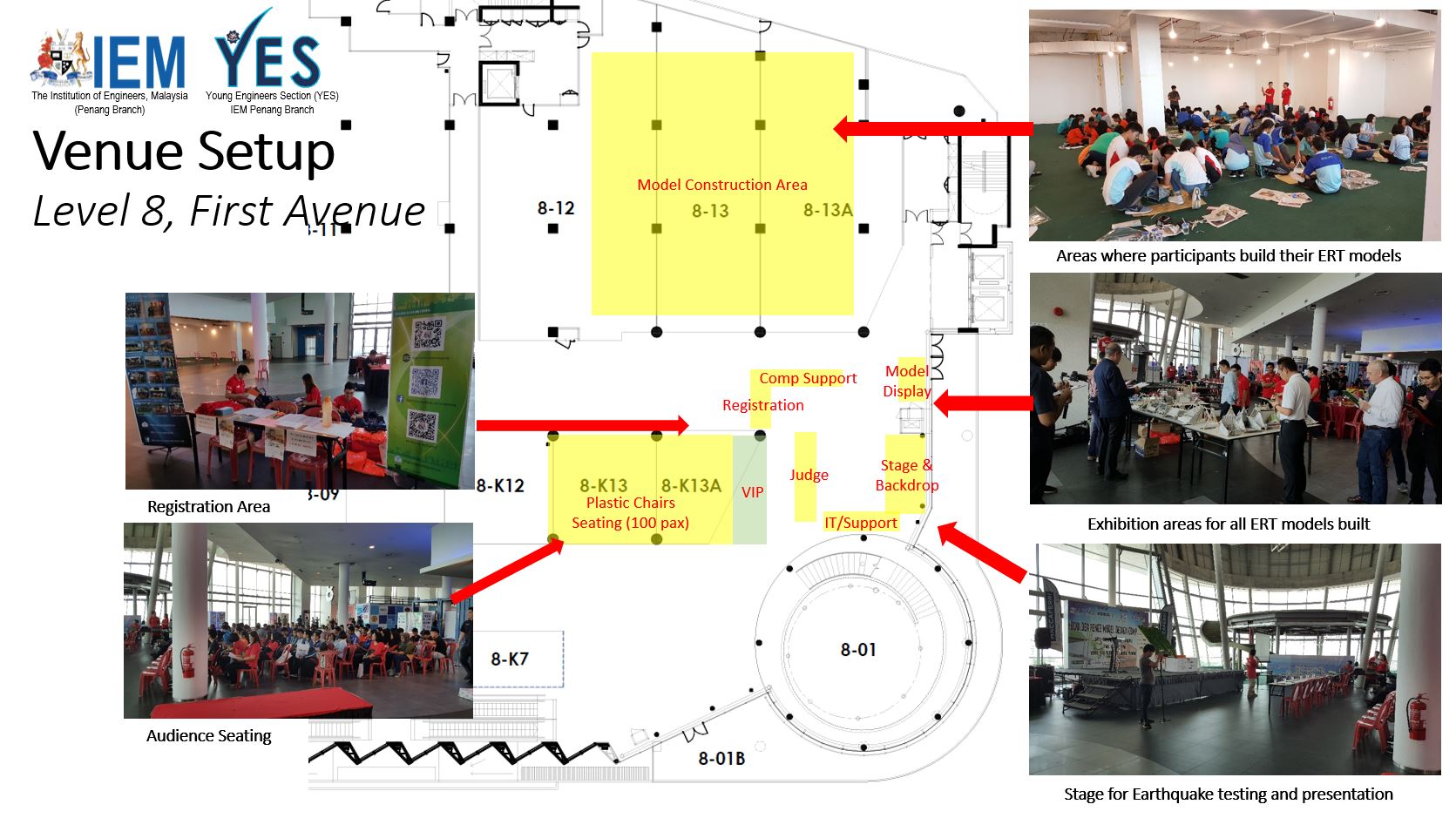
TENTATIVE PROGRAM
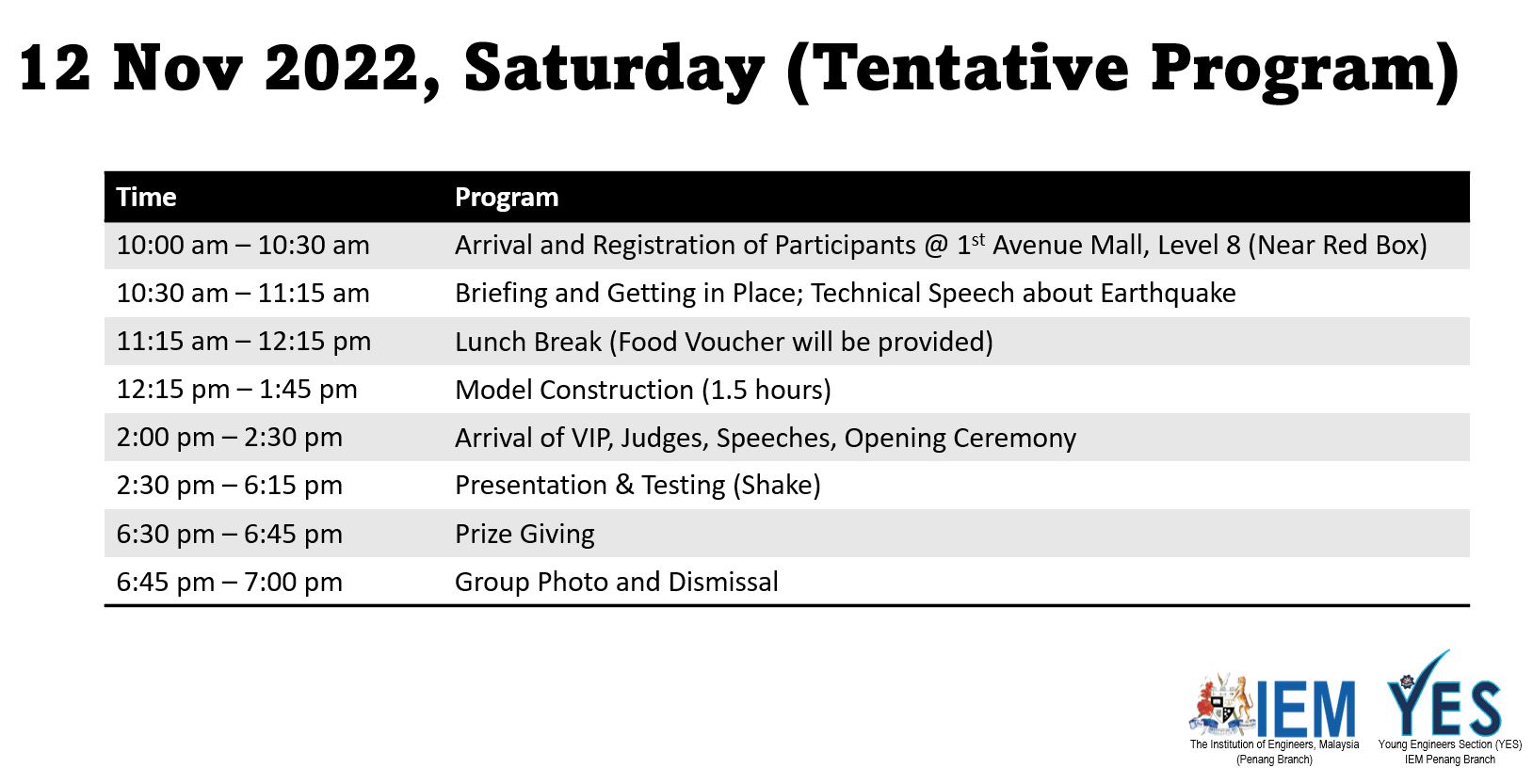
ATTIRE
All participants shall wear Long Pants for the event.
All participants to wear the ERT T-shirt and lanyard provided during the registration.
MEALS
- Food Voucher (RM8.50) will be provided during registration on the event day.
- Food Voucher is solely for participants in the IEM STEM ERT Design Competition 2022
- This Food Voucher can only be used at the 2 stalls stated below at The Food Hall, First Avenue Mall, 4th Floor
- Chili Pan Mee
- Sizzling & Claypot
- The voucher is not refundable and not exchangeable for cash, or any other forms of legal tender.
- During the redemption, if the food price exceeds the amount stated in the voucher, the difference thereof should be paid by the bearer (top-up).
- However, if the value of the food is less than the amount stated in the voucher then the difference thereof shall not be refunded to the bearer.
- Damaged vouchers will be considered invalid and will not be replaced.
- This voucher is only valid on 12 November 2022 (Saturday) lunch time only
- Dinner is not provided
GENERAL INFORMATION ABOUT EARTHQUAKE
Author:
Ir. CHUA BENG SEONG PKT
BSc PEng CEng FIEM FICE FASCE
Chair, Earthquake Engineering Sub-Committee,
Institution of Engineers, Malaysia (Penang Branch)
Earthquakes are vibrations of the earth’s surface caused by sudden movements of the earth’s crust which consists of a number of thick rock plates that float on the earth’s molten mantle.
The plates drift on convection currents generated by hot spots deep within the earth. As the plates move, due to interlocking at the plate boundaries, they deform. As a result, stress builds up and when the shear stress exceeds the strength of the rock, a rupture occurs along the fault line in the rock and energy is released in the form of seismic waves.
The origin of the fracture is known as the Focus of the earthquake (Figure 1). The point on the surface directly above the focus is called Epicentre of the earthquake.
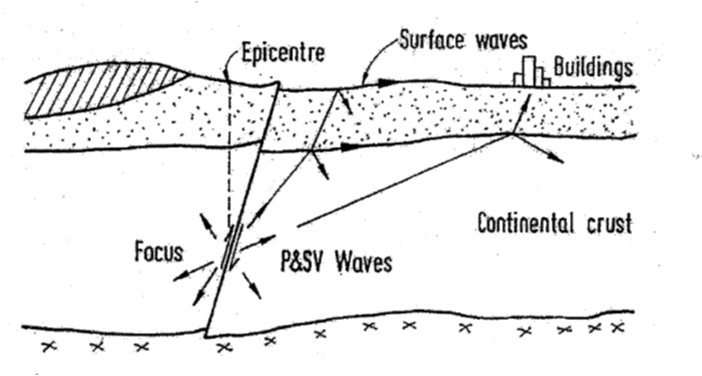
Figure 1 – Types of Seismic Wave
Two kinds of body waves are propagated from the focus:
- P waves (compressional), which is propagated as an expanding sphere of disturbance.
- S waves, which is characterized by shearing distortion without any volumetric change.
When body waves strike the free surface, they give rise to two kinds of surface waves:
- Love waves, which consist of horizontal motion of the surface transverse to the direction of propagation.
- Rayleigh waves, in which surface particles move in vertical retrograde elliptical orbits.
The body-wave amplitudes decay at the rate of r2, where r is radial distance from the focus.
The surface-wave amplitudes decay at the rate of r ½.
As the latter decay much less rapidly, the earthquakes may be felt hundreds of miles from their epicentre. That is the reason why the Peninsula Malaysia (particularly Penang Island which is about 500km from epicentre) still experienced the tremors as the result of the Sumatra earthquakes.
FREQUENTLY ASKED QUESTIONS
Q: Do the participants need to build the model before the competition?
A: No. Model construction will be done "on-site" or "on-the-spot" during the competition day only. "Pre-build" models will not be accepted.
Q: What are the materials provided for the construction of the model?
A: Refer above. Participants will not need to look for the materials on their own, and they will not be allowed to use any other materials than those provided for the model construction.
Q: Do the participants need to bring any tools to the competition?
A: Own tools are allowed but no materials including hot glue gun or other form of adhesives will be allowed.
Q: What is the attire for the competition?
A: T-shirts will be provided on the event day (during registration). Students are required to wear long pants.
Q: When is the registration deadline?
A: The registration is now full. Follow our fb page for more upcoming events.
Q: Will there be lunch provided?
A: Food Voucher will be provided. Refer above.
Q: Will there be transport provided to the competition venue?
A: No. Transportation to be arranged by the school or the participants themselves.
BRIEFING (06 NOV 2022, 9am - 10am)
Click links below for more details:
REGISTRATION FORM